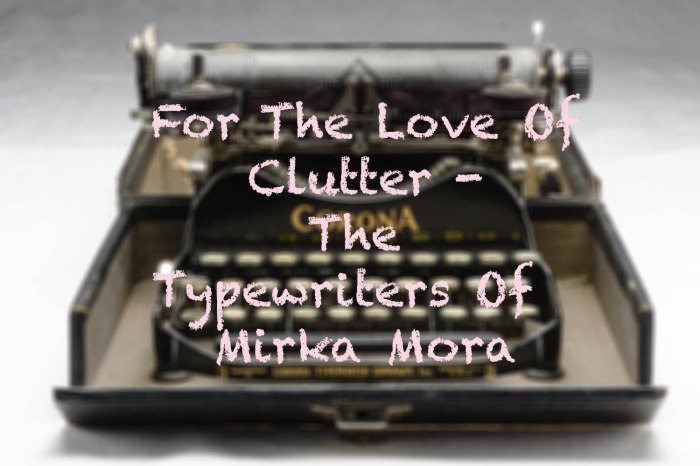 Earlier this year one of Melbourne’s more prestigious auction houses cleared the belongings from Mirka’s studio in Richmond. Calling the auction “The Magical Studio of Mirka Mora” ,they rebuilt much of the studio in their auction house in tribute to the artist – with the help of William, one of her sons. Mirka was well loved by Melbourne, and many were involved, hoping – as her son put it, to ‘take home a piece of Mirka ‘. Here’s a video the auction house produced before the auction.
Earlier this year one of Melbourne’s more prestigious auction houses cleared the belongings from Mirka’s studio in Richmond. Calling the auction “The Magical Studio of Mirka Mora” ,they rebuilt much of the studio in their auction house in tribute to the artist – with the help of William, one of her sons. Mirka was well loved by Melbourne, and many were involved, hoping – as her son put it, to ‘take home a piece of Mirka ‘. Here’s a video the auction house produced before the auction.
Two Corona 3 typewriters first appear at the 46 second mark, and you see much more of it around 1:10 to 1:18 minutes.
The woman at the centre of this love and clutter.
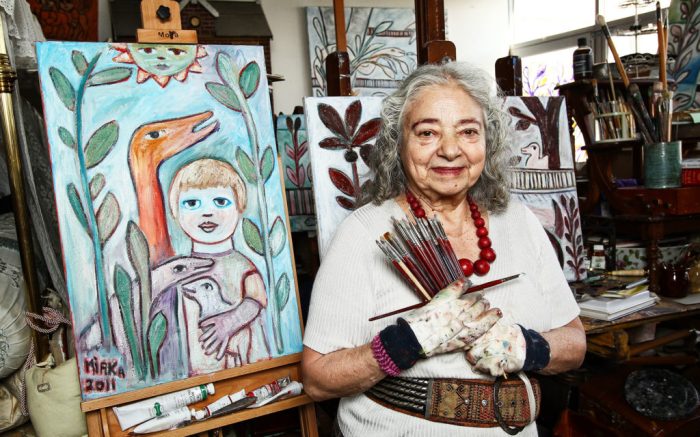
Photo by Graham Denholm. Image can be found at – http://grahamdenholm.com/portraits/
Who Is Mirka?
A city can have buildings but no soul. Art doesn’t just bring colour to the landscape, but pumps the blood through the cities veins. it gives it language, its drive and its people a perspective. As cities rise, some cities nurture an arts culture. Some don’t. Melbourne, Australia is one city very much of the former – and has become a great because of it.
I could write dozens upon dozens of blogs about what it is about Melbourne that gave it such a thriving arts scene. Dozens more about why it is so different to other cities in Australia or even the world. There’s just something about our city.
But it wasn’t always this way. Once Melbourne could have easily fallen into the cultural drudgery of other Australian cities. But after the second world war Melbourne flooded with immigrants fleeing the wreckage of Europe the city changed dramatically.
To some, artist Mirka Mora was the heart of this change. Born to Jewish parents, she escaped from a german concentration camp before her and her mother were to be sent to Auschwitz. She hid in the forests of France to avoid being recaptured for 3 years, married a French resistance fighter after the war, then Moved to Melbourne.
Here, her husband and her setup a cafe. Soon they became key figures in the Melbourne cultural scene, and when they set up a gallery, they became key drivers in the exploding arts scene of the city – socialising with some of the greatest artists of the era. The modernists had arrived, and no longer was the city content with the pale nationalistic rural story-telling of the old guard. Things after that became pretty interesting.
Adored by many, she was a powerhouse of a woman and a well known around much of Melbourne. Known for her wit and passion, Mirka seemed to be interviewed on everything from painting to sex. Her work quite literally coloured the streets as her art filled cafes, homes, galleries, murals and even the sides of trams. Her work didn’t capture the soul of the city, but rather gave birth to it.
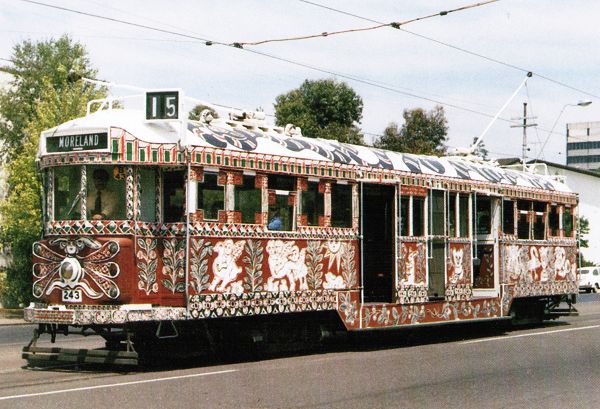
From the archive of the Melbourne Tram Museum.
Sadly, on the 27th of August 2018, Mirka passed away at the age of 90.
My first memory of meeting Mirka was back in the late 90’s. It’s my first memory, but I probably met her earlier. Myself and another guy ran a stall at the Queen Vic market selling umbrellas – a small retail outlet for our slowly building import and wholesale business. She was travelling with a colourful, ageing and heavily tattoo’d woman that my college was certain was another Australian artist – ‘Madame Lash'(I wasn’t so sure of that myself though). Mirka was the cool minded and kind witted persona contrasting Lash’s acidic tongue. Our french impressionist printed umbrellas were vulgar offences to art, Lash berated. Mirka giggled but chatted away to me before both left.
3 weeks later Mirka returned to buy a colourful rainforest print Umbrella we were clearing out. Every so often she would pop by and have a look over the years when casually around the market.
Taking home a piece of Mirka.
As her son said affectionately, everyone was hoping to take home a piece of Mirka. When I first saw this collection come up, I didn’t realise how literal this would be.
But more on that in a moment.
Between the used brushes, clothing, worn and paint splattered furniture items, completed artworks and semi-completed paintings, two typewriters appeared in the catalogue: 
Corona 3s. From a collector point of view these machines – while common, are still nice machines to have in anyone’s collection. However Mirka had hidden over 400 letters that she received from friends, family and… well… I guess you could call them fans. One of those letters placed inside the typewriter case of one of these Corona 3s.
And fans she had. The auction hall filled with to capacity. Many watched online as the auction unfolded, including myself – as I was working that day. The next day weary lovers of her work lamented online their adoration for Mirka, and were despondent about how much so many of her items went for. “I can’t believe how much people paid for stuff. People must be made of money. I interviewed her in herstudio as a student a couple of times and I just wanted something to remember her with. But I couldn’t afford anything” a woman explained on facebook, with many concurring.
Several galleries put together campaigns to acquire as many artefacts and artworks as possible. The Heide Museum of Modern Art had the biggest crowd-funding campaign, and managed to snap up many items – The design files website was a large sponsor and supporter, and you can read about some of their acquisitions here
Maybe it was just delirium from working so much. Maybe it was just because my finances were so good from over-working, I threw my hat in the ring for the typewriters. I set a maximum I’d go, put in an online automatic bid to that amount,and went to work.
By the time I finished work the auction had yet to finished. So I popped it up on my screen at home and waited. The typewriters came up and within seconds my maximum bid was exceeded. Oh well! I watched it slip away as one of those crowd-funded groups bid hard.
My bid was already twice the estimated value amount, but still considerably less than what I expected them to go for. I had bid low in the hope of maybe picking up an over-looked bargain.
But bidding stalled a little after I was outbid. Moments before the hammer fell something weird happened… Something I can’t really explain. For some reason I bashed the bid button again, and threw a few more dollars at it. The crowd-funding group bid against me, And.. well… I replied. And that was it.
Two days later I was at the auction house. I paid, went up stairs and collected my typewriters, passing numerous artworks and pieces being slowly taken away by their owners. As I walked down the stairs with the typewriters cradled in my arms, I kinda felt a little pathetic carrying these while others around me wandered down with artworks that were solid ‘long term investments’. But as I passed a staff member out the front, she lit up with a smile and said to me “oh! YOU have got the typewriters”.
The hidden secrets of the Coronas.
So there I was – with a Corona 3 in its case, and a Corona special that was not. The older of the two, the one in the case, is one of the best examples of the Corona 3 I have ever had the privilege to see. The machine, outside of some dust, is in near perfect condition. This typewriter, other than the ageing and used platen, feels and looks like it did when it came from the shop. Right down to the feet, which haven’t turned into a mash of rubber putty and still retain their original shape.


Although the typewriter looks barely used, the platen however tells a very different story. It is dry and pitted, but has been typed on fairly recently with lines of philosophy. The ribbon also has been changed sometime in the last 20 years, with the ink on the platen matching the colour of the text.
In my mind I imagined night of drink, conversation and artistic flurry by famous artists who suddenly wanted to start bashing at the keys for some poetry. But chances are it was some student that was bored and mischievous in the studio.
Naturally I pulled the letter out. The letter is addressed to a former residence of Mirka’s in St Kilda.

Inside is a thank-you letter. I won’t publish it on here, as I don’t want to make it easy for other ‘Mirka Mora’ typewriter fakes to be produced. But suffice to say it was a letter written by a friend with the utmost affection.
The typewriter’s cleaning and oiling tools are still intact in the case, as well as the original manual.

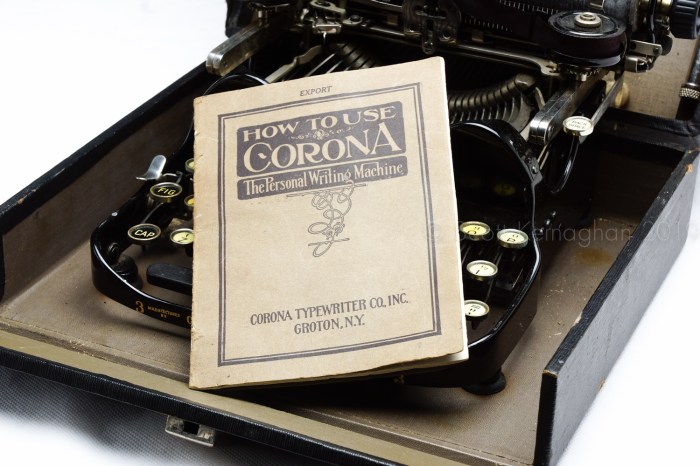
As I was taking these photos, I found another surprise when I opened up the manual. Inside was another letter. Not to or from Mirka, but instead a letter of guarantee to the first owner of this typewriter from the business it was bought from.

What I may never find out though, is the person who scrawled their initials on it at a later point, across the handle side of the case. The handle itself is the only item on this whole piece that shows any real damage. If you look closely enough you can see ‘S. B. B.’

The engineering school listed in this letter is part of what is now Melbourne University, so I am confident I will be able to find out who the first owner was.
The second typewriter of the pair could not have been more different. The machine was in appalling condition, and with the original ribbon splayed across the machine awkwardly, full of rot, I was uncomfortable with moving too much around as I wasn’t sure what kind of crud would come out of this machine.

But it may be because of the dirt and the dislodged ribbon that hid some of the other surprises that this machine held.
I flipped the typewriter up to look for the serial number, only to be surprised by the distinct lack of serial number. It’s not that I can’t find it, but rather it wasn’t there. Instead there’s a patch of scratched metal where the serial number had been ground away.
While looking for the serial however, I found an even more interesting discovery. Tied around the space bar loosely, was what appeared to be one of Mirka’s distinctive long, curly-wavy, thick grey hairs.
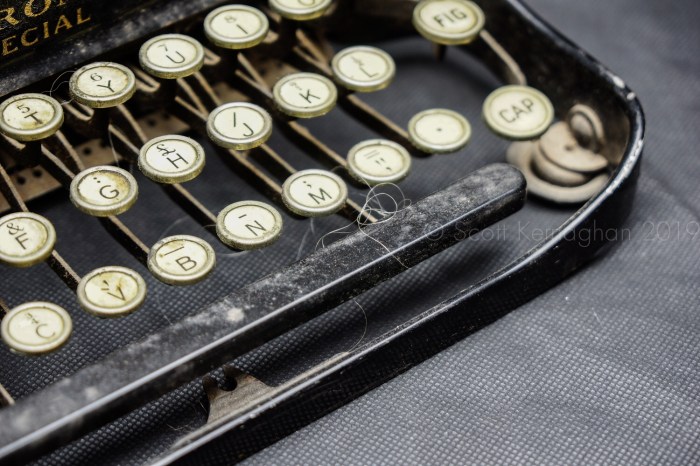

The hair seems intentionally placed, even though it is mostly wrapped around the bottom of the typewriter. There is a knot just behind the spacebar near the keys that has ensured that this hair doesn’t work loose intentionally. A quick visit back to the auction catalogue online and I can see, although not obvious to a cursory glance, in the photos the hair present. This wasn’t just something picked up after the typewriter left the auction house.
The words of Mirka’s son William still continue to resonate. It wasn’t intentional, but it is likely that I literally did take a piece of Mirka home with me. The many times I have thought about how it would be cool to be able find the evidence of the former users of a typewriter buried somewhere, deep down inside. And now… here I have two machines that have their history written in, written on, and draped across them. It is a truly wonderous and beautiful thing.
Mirka wrote a book called ‘Love and clutter‘. By no stretch of the imagination was Mirka a a minimalist. And that’s just fine by me. And I’m happy to have her typewriters in my home.
Hmmn, someone with access to advanced medical equipment and a sample of someone’s DNA.. This could get even more surprising! 😀
LikeLike
Oh believe me.. I’ve contemplated it!
LikeLike
Beautiful Corona 3. The hair may be even more interesting than the typewriter.
LikeLike
You know. I think it is. This Corona special wouldn’t get anything if I put it on eBay. It’s interesting how an identifying piece can make all the difference.
LikeLike
Nice memories of Mirka, she was very well known around St Kilda and Elsternwick, where I lived in the ’60s. There was a story, a true one, of Mirka’s mischievous sense of humour, when one day at her little cafe she cut two little holes in her blouse so that each nipple poked through! As you could imagine, it caused no end of scandalized muttering, much to the delight of Mirka. I am glad that your heart overcame your head and like any true collector went for the prize like a big game hunter. You will cherish the machines long after the pain fo paying for them has receded.
LikeLike
I have heard she did such things before! She reportedly had a very vibrant sex life.
LikeLike
Wonderful to read and listen. Thanks for sharing a piece of Murka.
LikeLike
Thanks!
LikeLike
Great additions to your collection. I love the tram she decorated!
LikeLike
Quite the piece! Apparently that tram is in someone’s backyard now.
LikeLike